Wide ranging appeal
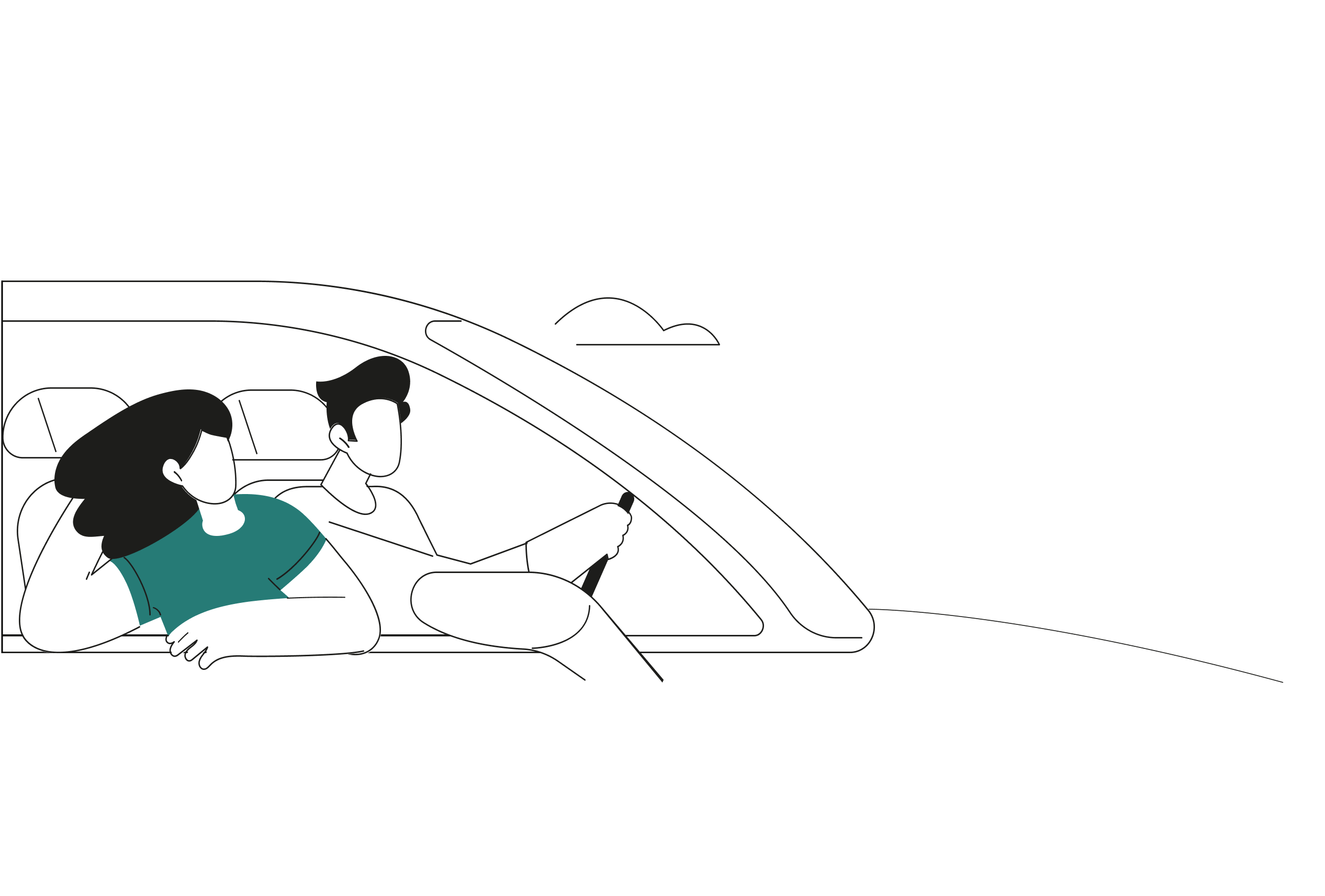

A concept that is clearly identified
Although, as we have pointed out, the term SUV and its definition are based on a somewhat ambiguous identity, with boundaries that shift from one country to the next and according to whether or not one owns such a vehicle, people seem to have a clear perception of the concept.
Motorists highlight two “physical” criteria that characterise the specific design of SUVs. 34% mention a spacious passenger compartment (Fig 15).
Close to 1 in 2 respondents in China, the US, South Africa, Brazil and Portugal cite this feature. This is a view that the Norwegians, Japanese, Germans, Belgians and Poles are much less likely to share.
Fig 15 – Perceived attributes of SUVs
Download this infographic for your presentations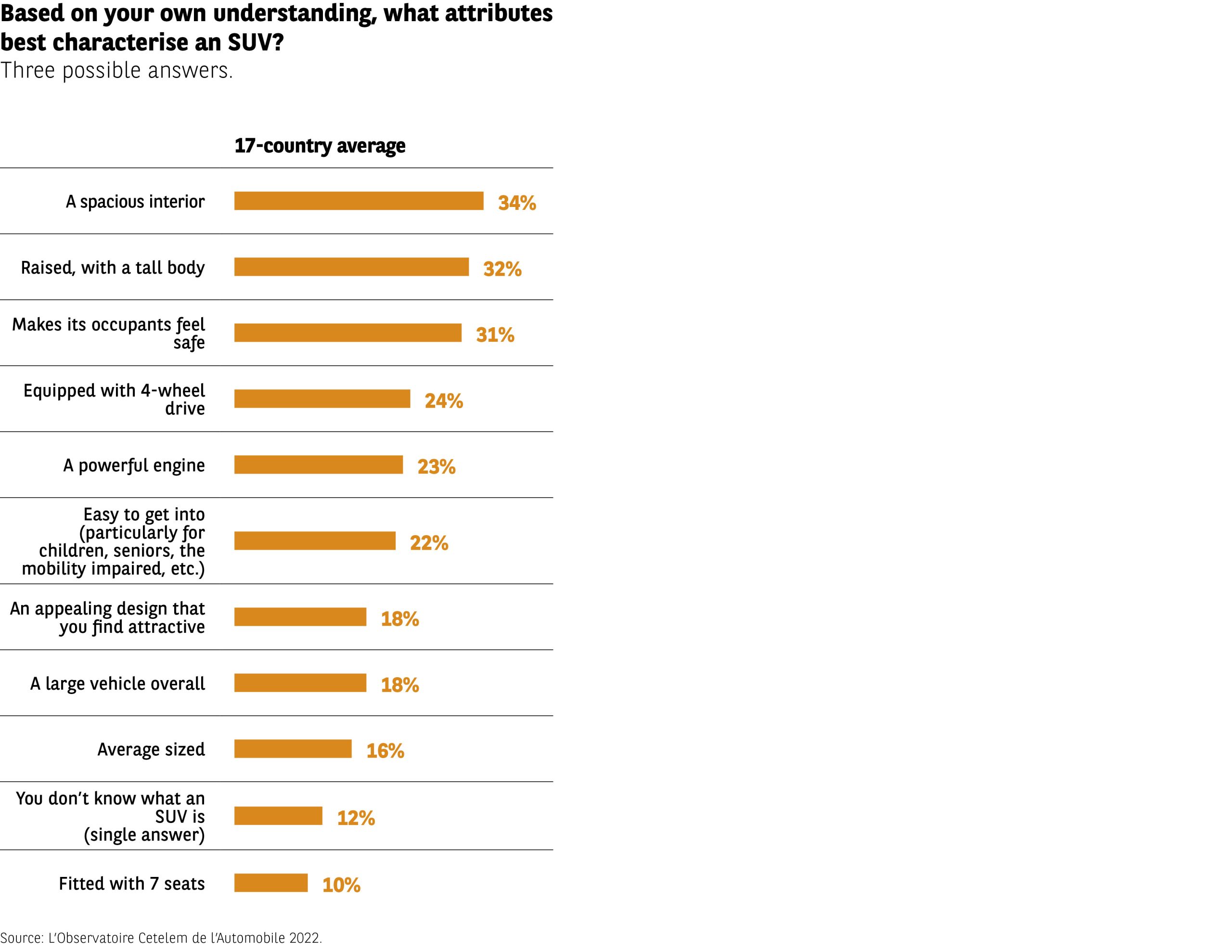 the infographic shows which attributes respondents associate with SUVs. Up to three answers allowed. Results reflect averages across 17 countries.
Data:
Spacious interior: 34%
Raised body height: 32%
Feeling of safety: 31%
Four-wheel drive: 24%
Powerful engine: 23%
Easy access (children, elderly, reduced mobility): 22%
Attractive design: 18%
Large interior volume: 18%
Medium-sized vehicle: 16%
Don’t know what an SUV is: 12%
Seven-seat model: 10%
Main takeaway: space, driving height and safety are the most frequently cited attributes.
Source: L’Observatoire Cetelem de l’Automobile 2022.
the infographic shows which attributes respondents associate with SUVs. Up to three answers allowed. Results reflect averages across 17 countries.
Data:
Spacious interior: 34%
Raised body height: 32%
Feeling of safety: 31%
Four-wheel drive: 24%
Powerful engine: 23%
Easy access (children, elderly, reduced mobility): 22%
Attractive design: 18%
Large interior volume: 18%
Medium-sized vehicle: 16%
Don’t know what an SUV is: 12%
Seven-seat model: 10%
Main takeaway: space, driving height and safety are the most frequently cited attributes.
Source: L’Observatoire Cetelem de l’Automobile 2022.
The second characteristic that motorists believe distinguishes SUVs is the vehicle’s raised body (32%).
The Italians and Germans, together with the South Africans and Turks, are the most likely to cite this feature, while the Poles and Mexicans in particular pay little attention to it (just 7% and 14%). In third place is the feeling of safety that motorists feel SUVs procure, with a similar proportion voicing this opinion (31%). Once again, this result seem to be influenced by the way this type of vehicle is designed, i.e., its silhouette is generally bulkier than that of a traditional saloon car. Indeed, it is no coincidence that the raised stance of these vehicles, which is often synonymous with safer driving, achieves an almost identical score. The Mexicans are the most likely to mention this feeling of safety, while around half as many Brits are convinced about this attribute.
The remaining criteria are put forward by less than a quarter of respondents. It is interesting to note that 4-wheel drive comes fourth in the ranking, despite the fact that it is a rare feature on today’s SUVs.
A vehicle with solid values…
It makes sense that the technical features people mention when they identify SUVs translate into corresponding “values”, with the top five being particularly prominent.
In the eyes of motorists, SUVs are family vehicles first and foremost (28%). The South Africans, Portuguese and Mexicans are the most likely to make this point, with the Japanese and, perhaps more surprisingly, the Turks finding themselves at the other end of the scale. We say surprisingly because although in Japan the birth rate is very low and the family-friendliness of a vehicle is therefore less important, Turkey’s birth rate is significantly higher (1.36 and 2.38 children per woman in 2019, respectively – Source: World Bank).
The third most cited value among motorists is safety (26%), an attribute that is clearly associated with SUVs to a relatively similar degree in all countries (Fig 16).
However, the Turks, Italians and Americans are the most mindful of this factor, while the Japanese, once again, and the Poles place less importance on the issue.
Fig 16 – Comparison between SUVs and the ideal car
Download this infographic for your presentations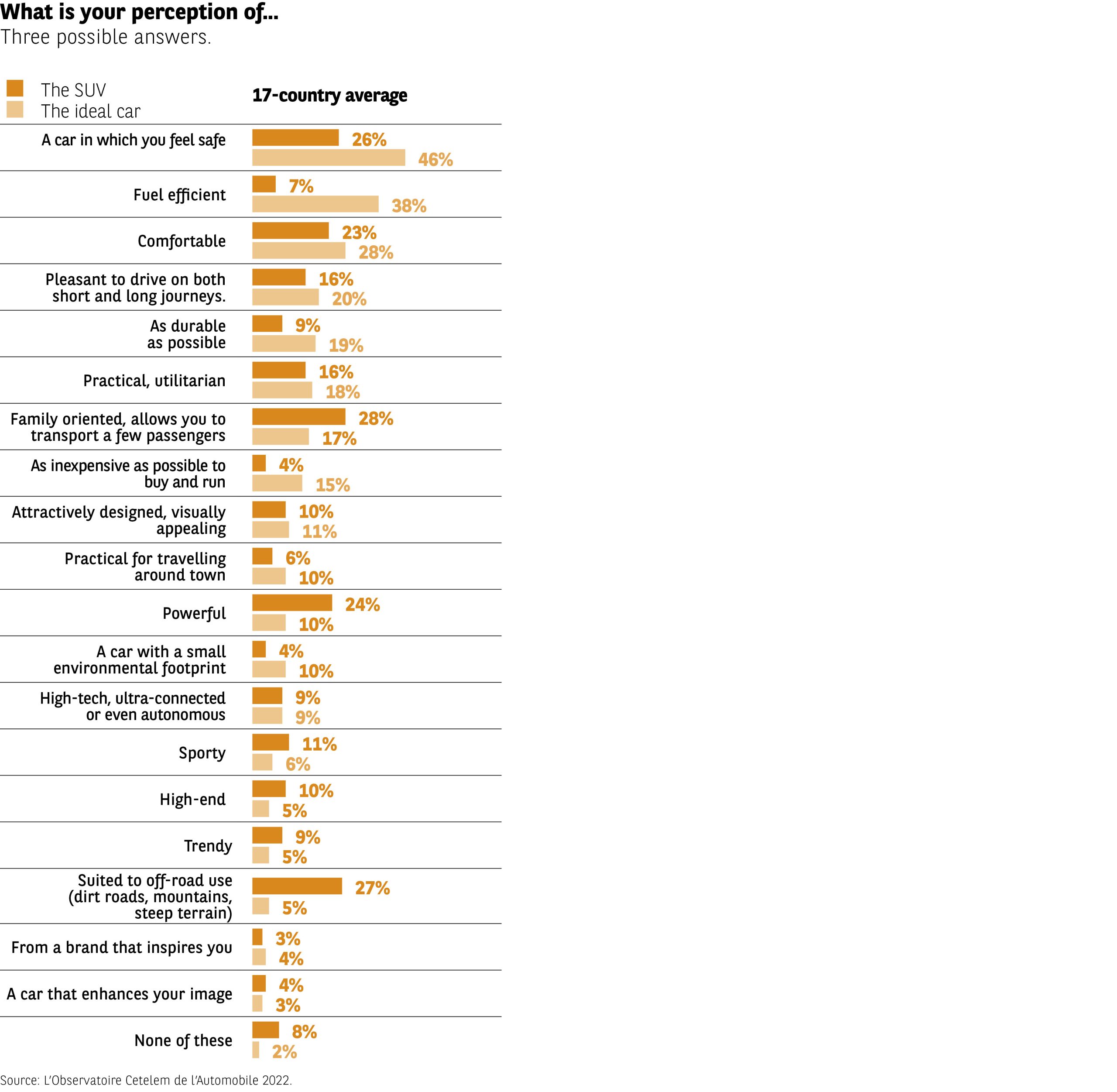 The infographic compares the qualities attributed to SUVs with those associated with the ideal car.
Data (SUV / ideal car):
Safe: 26% / 46%
Low fuel consumption: 7% / 38%
Comfortable: 23% / 28%
Pleasant to drive: 16% / 20%
Long-lasting: 9% / 19%
Functional: 16% / 18%
Suitable for families: 28% / 17%
Low cost: 4% / 15%
Attractive design: 10% / 11%
Practical in the city: 6% / 10%
Powerful: 10% / 24%
Low environmental impact: 4% / 10%
Technological: 9% / 9%
Sporty: 6% / 11%
Premium: 5% / 5%
Trendy: 9% / 5%
Off-road capable: 5% / 27%
From an inspiring brand: 3% / 4%
Image-enhancing: 4% / 3%
None: 8% / 2%
Main takeaway: the ideal car is mainly seen as safe, efficient, and powerful, while SUVs are viewed as more family-oriented.
Source: L’Observatoire Cetelem de l’Automobile 2022.
The infographic compares the qualities attributed to SUVs with those associated with the ideal car.
Data (SUV / ideal car):
Safe: 26% / 46%
Low fuel consumption: 7% / 38%
Comfortable: 23% / 28%
Pleasant to drive: 16% / 20%
Long-lasting: 9% / 19%
Functional: 16% / 18%
Suitable for families: 28% / 17%
Low cost: 4% / 15%
Attractive design: 10% / 11%
Practical in the city: 6% / 10%
Powerful: 10% / 24%
Low environmental impact: 4% / 10%
Technological: 9% / 9%
Sporty: 6% / 11%
Premium: 5% / 5%
Trendy: 9% / 5%
Off-road capable: 5% / 27%
From an inspiring brand: 3% / 4%
Image-enhancing: 4% / 3%
None: 8% / 2%
Main takeaway: the ideal car is mainly seen as safe, efficient, and powerful, while SUVs are viewed as more family-oriented.
Source: L’Observatoire Cetelem de l’Automobile 2022.
In between the two, the off-road capabilities of SUVs are singled out by 27% of respondents. In this instance, the disparities are much more marked. For example, three times as many Italians as Americans refer to this point. This is a result that challenges the cliché of the United States being a nation where people are always travelling across vast open spaces with no shortage of obstacles to clear.
Rounding out the quintet of values that motorists most commonly associate with SUVs, power and comfort achieve scores of 24% and 23%, respectively. The Dutch and Germans are the most inclined to mention power, while the opposite is true of the French and Portuguese.
The comfort factor is most frequently cited by the “distant cousins” of Brazil and Portugal, while the Norwegians and Japanese show little concern for this attribute. It is worth noting that SUVs are rarely viewed as being fuel efficient (7%) (Fig 17).
Fig 17 – Perceived characteristics of an SUV
Download this infographic for your presentations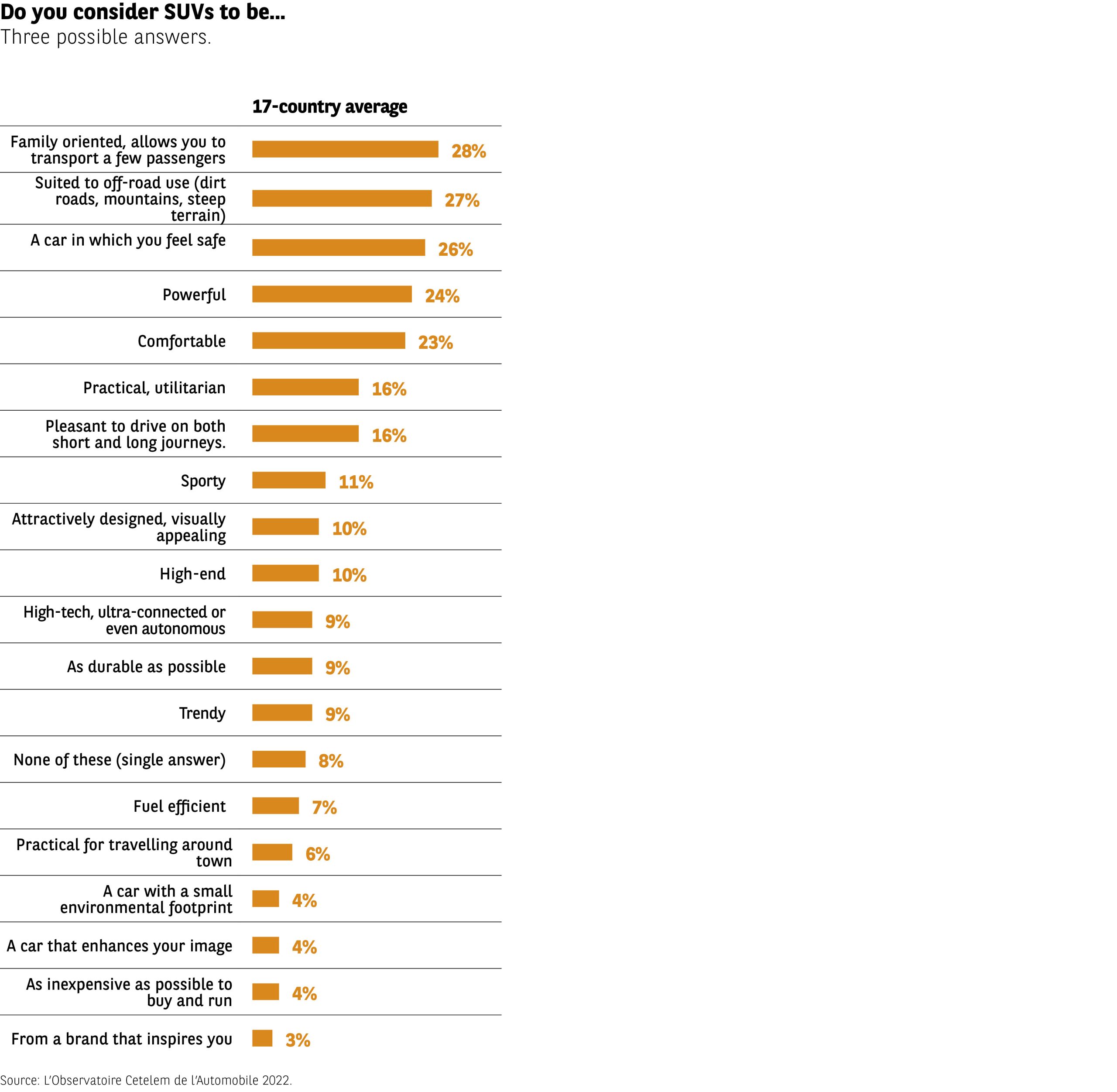 The infographic presents the qualities respondents attribute to SUVs.
Data:
Suitable for family travel: 28%
Off-road capable: 27%
Safe: 26%
Powerful: 24%
Comfortable: 23%
Functional: 16%
Pleasant to drive: 16%
Sporty: 11%
Attractive design: 10%
Premium: 10%
Technological: 9%
Long-lasting: 9%
Trendy: 9%
None of these: 8%
Low fuel consumption: 7%
Practical for city use: 6%
Low environmental impact: 4%
Image-enhancing: 4%
Low purchase/usage cost: 4%
From a brand that inspires dreams: 3%
Main takeaway: SUVs are mainly perceived as family-friendly, versatile and safe.
Source: L’Observatoire Cetelem de l’Automobile 2022.
The infographic presents the qualities respondents attribute to SUVs.
Data:
Suitable for family travel: 28%
Off-road capable: 27%
Safe: 26%
Powerful: 24%
Comfortable: 23%
Functional: 16%
Pleasant to drive: 16%
Sporty: 11%
Attractive design: 10%
Premium: 10%
Technological: 9%
Long-lasting: 9%
Trendy: 9%
None of these: 8%
Low fuel consumption: 7%
Practical for city use: 6%
Low environmental impact: 4%
Image-enhancing: 4%
Low purchase/usage cost: 4%
From a brand that inspires dreams: 3%
Main takeaway: SUVs are mainly perceived as family-friendly, versatile and safe.
Source: L’Observatoire Cetelem de l’Automobile 2022.
… but which does not equate to the ideal car
In the minds of motorists, the aforementioned fuel efficiency criterion is one of those that does the most to differentiate the SUV from the ideal car. 38% view it as a priority and it is preceded only by safety. This ideal of a fuel-efficient car is expressed by almost 1 in 2 people in Portugal, Poland, Brazil and South Africa, compared with only a quarter of Chinese and American respondents. The ideal of a car that makes one feel safe is more universal, although its importance appears to be greater in Spain, Italy and Brazil, but less so in France.
However, most striking are the disparities that appear when numerous other criteria are examined.
Indeed, SUVs are family cars in the opinion of 28% of those surveyed, while only 17% believe the same can be said of the ideal vehicle. And this is also true of certain other criteria: while 24% consider SUVs to be powerful vehicles, only 10% think that the ideal vehicle is also powerful. Conversely, 15% believe that the ideal car would cost as little as possible to buy and use, while just 4% think that SUVs meet these criteria. Only three items generate practically identical scores on both sides, three of which relate to style and design.
Characteristics and uses: a good level of consistency
The way in which SUV owners use their vehicle tends to be consistent with the image they have of this type of vehicle: a family car that offers peace of mind when it comes to safety. 68% of them use their car mainly to go on holiday or for weekends away, 7 points more than non-SUV owners (Fig 18). On this topic, the results again differ significantly from country to country. Turkey, Poland, Italy and Spain are the countries in which SUV owners are the most inclined to use their car to go on holiday, while the Norwegians, Dutch, Chinese, British and Germans are much less likely to use them for leisure purposes and holiday travel. It is interesting to note the marked differences that appear between owners and non-owners of SUVs in Japan and the Netherlands, differences that are practically non‑existent in Norway and China.
Fig 18 – Frequency of using vehicles for leisure trips
Download this infographic for your presentations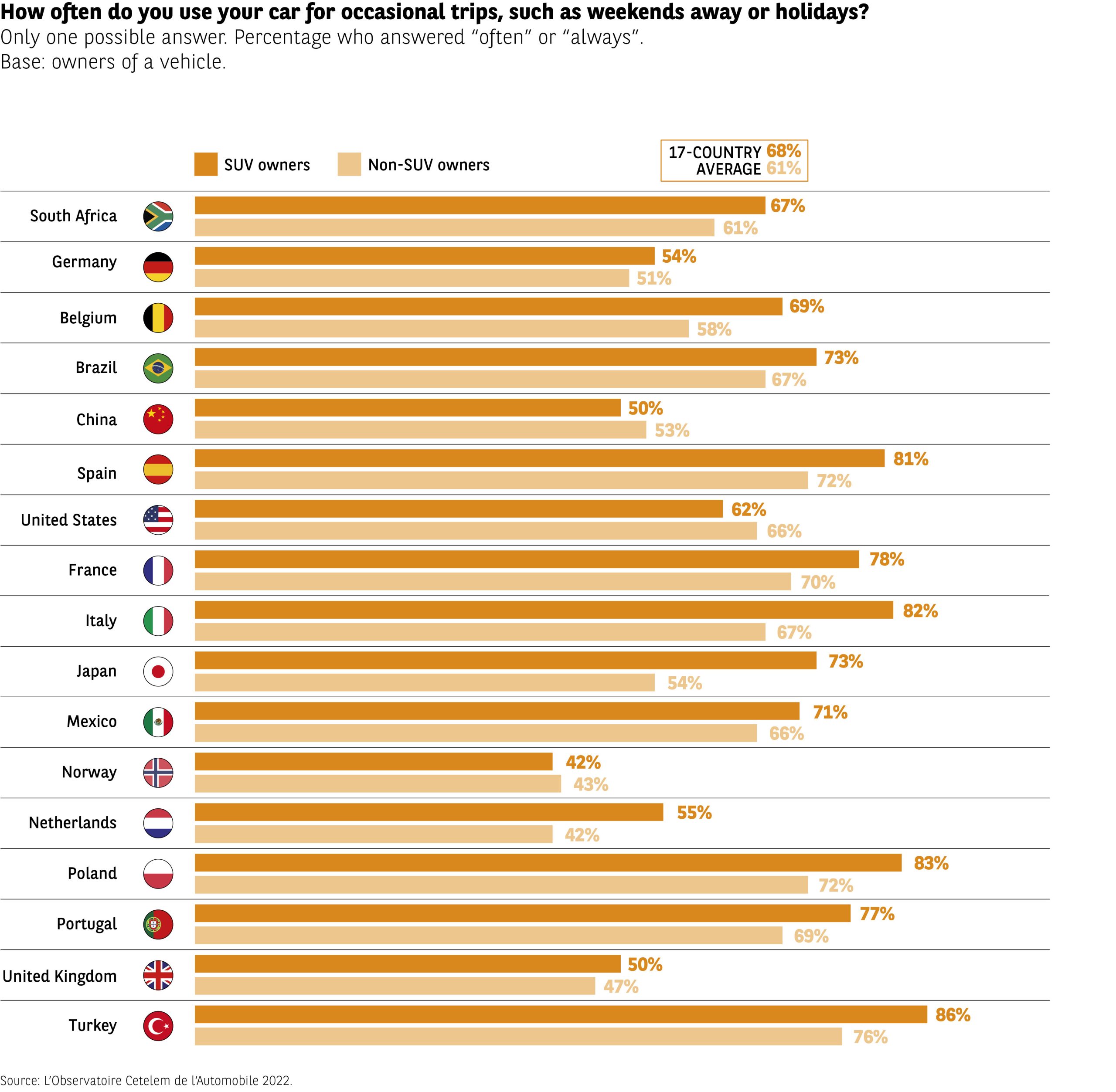 The infographic shows the share of respondents who use their vehicle often or systematically for occasional trips such as weekends or vacations. Two groups are compared: SUV owners and non-owners.
The 17-country averages shown are 68% for owners and 61% for non-owners.
Data by country:
South Africa: 67% (non-owners not shown)
Germany: 54% owners, 51% non-owners
Belgium: 69% / 58%
Brazil: 73% / 67%
China: 50% / 53%
Spain: 81% / 72%
United States: 62% / 66%
France: 78% / 70%
Italy: 82% / 67%
Japan: 73% / 54%
Mexico: 71% / 66%
Norway: 42% / 43%
Netherlands: 55% / 42%
Poland: 72% / 69%
Portugal: 77% / 72%
United Kingdom: 50% / 47%
Turkey: 86% / 76%
Main takeaway: SUV owners generally report higher leisure-trip usage, with some variations by country.
Source: L’Observatoire Cetelem de l’Automobile 2022.
The infographic shows the share of respondents who use their vehicle often or systematically for occasional trips such as weekends or vacations. Two groups are compared: SUV owners and non-owners.
The 17-country averages shown are 68% for owners and 61% for non-owners.
Data by country:
South Africa: 67% (non-owners not shown)
Germany: 54% owners, 51% non-owners
Belgium: 69% / 58%
Brazil: 73% / 67%
China: 50% / 53%
Spain: 81% / 72%
United States: 62% / 66%
France: 78% / 70%
Italy: 82% / 67%
Japan: 73% / 54%
Mexico: 71% / 66%
Norway: 42% / 43%
Netherlands: 55% / 42%
Poland: 72% / 69%
Portugal: 77% / 72%
United Kingdom: 50% / 47%
Turkey: 86% / 76%
Main takeaway: SUV owners generally report higher leisure-trip usage, with some variations by country.
Source: L’Observatoire Cetelem de l’Automobile 2022.
SUVs go the distance
Not only do SUVs spend more time on the road during the holidays, they tend to cover more distance in general. Every year, SUV owners drive an average of 15,251 km compared with just 13,506 km in the case of non-owners (Fig 19).
And in all countries, those who drive the most are SUV owners. In Italy and Spain, the gap between the two categories of motorist exceeds 3,000 km per year, while in the Netherlands, South Africa, China and Brazil the difference is less than 1,000 km. The interior space, comfort and safety offered by SUVs seem to encourage their owners to cover greater distances.
Fig 19 – Estimated annual mileage by country
Download this infographic for your presentations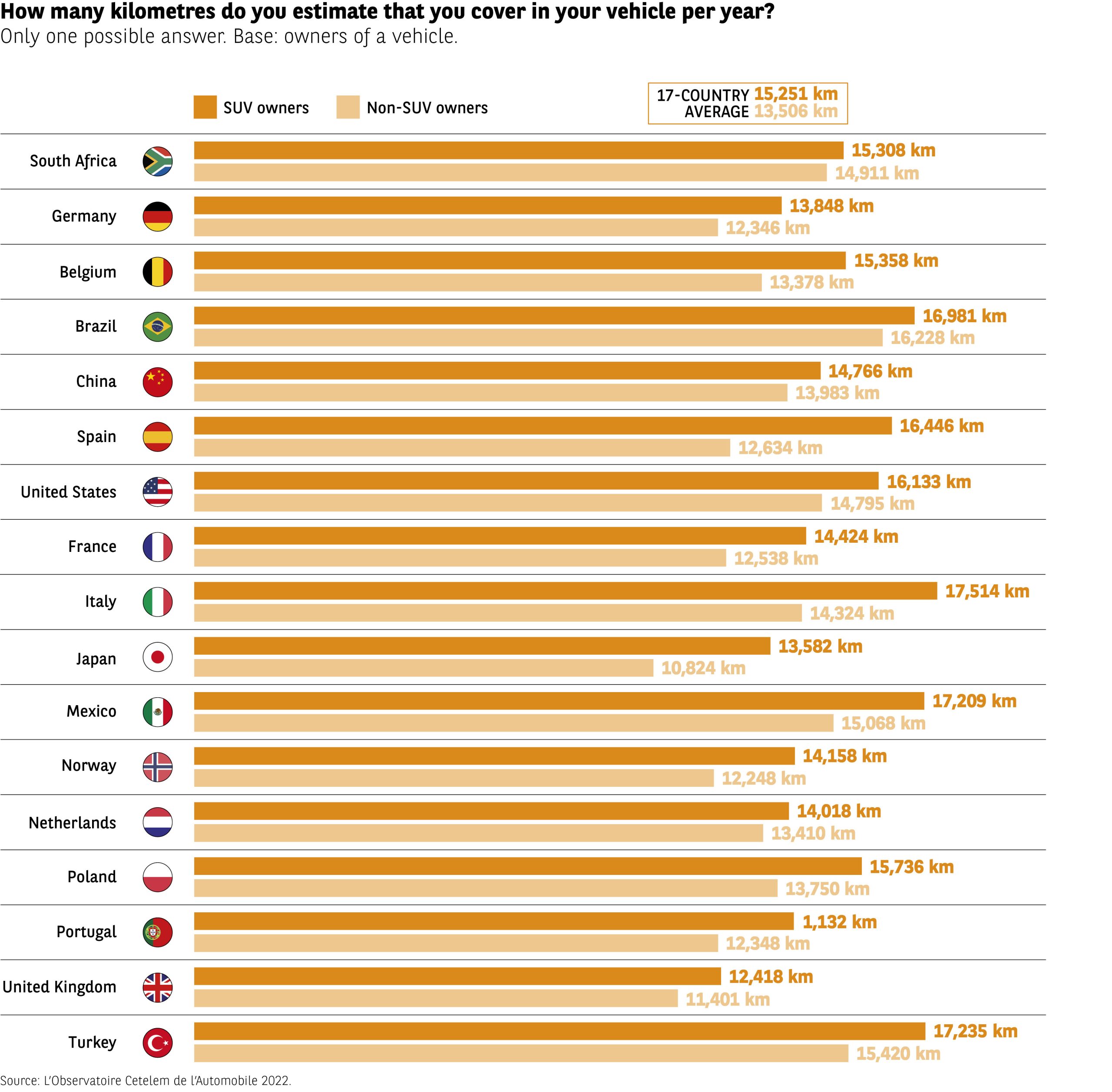 the infographic displays, for 17 countries, the number of kilometers respondents believe they drive per year. Two groups are shown: SUV owners and non-owners.
Reported averages are 15,251 km for owners and 13,506 km for non-owners.
Data by country:
South Africa: 15,308 km owners, 14,911 km non-owners
Germany: 13,848 km / 12,346 km
Belgium: 15,358 km / 13,378 km
Brazil: 16,981 km / 16,228 km
China: 14,766 km / 13,983 km
Spain: 16,446 km / 12,634 km
United States: 16,133 km / 14,795 km
France: 14,424 km / 12,538 km
Italy: 17,514 km / 14,324 km
Japan: 13,582 km / 10,824 km
Mexico: 17,209 km / 15,068 km
Norway: 14,158 km / 12,248 km
Netherlands: 14,018 km / 13,410 km
Poland: 15,736 km / 13,750 km
Portugal: 14,132 km / 12,348 km
United Kingdom: 12,418 km / 11,401 km
Turkey: 17,235 km / 15,420 km
Main takeaway: in every country, SUV owners estimate higher annual mileage.
Source: L’Observatoire Cetelem de l’Automobile 2022.
the infographic displays, for 17 countries, the number of kilometers respondents believe they drive per year. Two groups are shown: SUV owners and non-owners.
Reported averages are 15,251 km for owners and 13,506 km for non-owners.
Data by country:
South Africa: 15,308 km owners, 14,911 km non-owners
Germany: 13,848 km / 12,346 km
Belgium: 15,358 km / 13,378 km
Brazil: 16,981 km / 16,228 km
China: 14,766 km / 13,983 km
Spain: 16,446 km / 12,634 km
United States: 16,133 km / 14,795 km
France: 14,424 km / 12,538 km
Italy: 17,514 km / 14,324 km
Japan: 13,582 km / 10,824 km
Mexico: 17,209 km / 15,068 km
Norway: 14,158 km / 12,248 km
Netherlands: 14,018 km / 13,410 km
Poland: 15,736 km / 13,750 km
Portugal: 14,132 km / 12,348 km
United Kingdom: 12,418 km / 11,401 km
Turkey: 17,235 km / 15,420 km
Main takeaway: in every country, SUV owners estimate higher annual mileage.
Source: L’Observatoire Cetelem de l’Automobile 2022.
